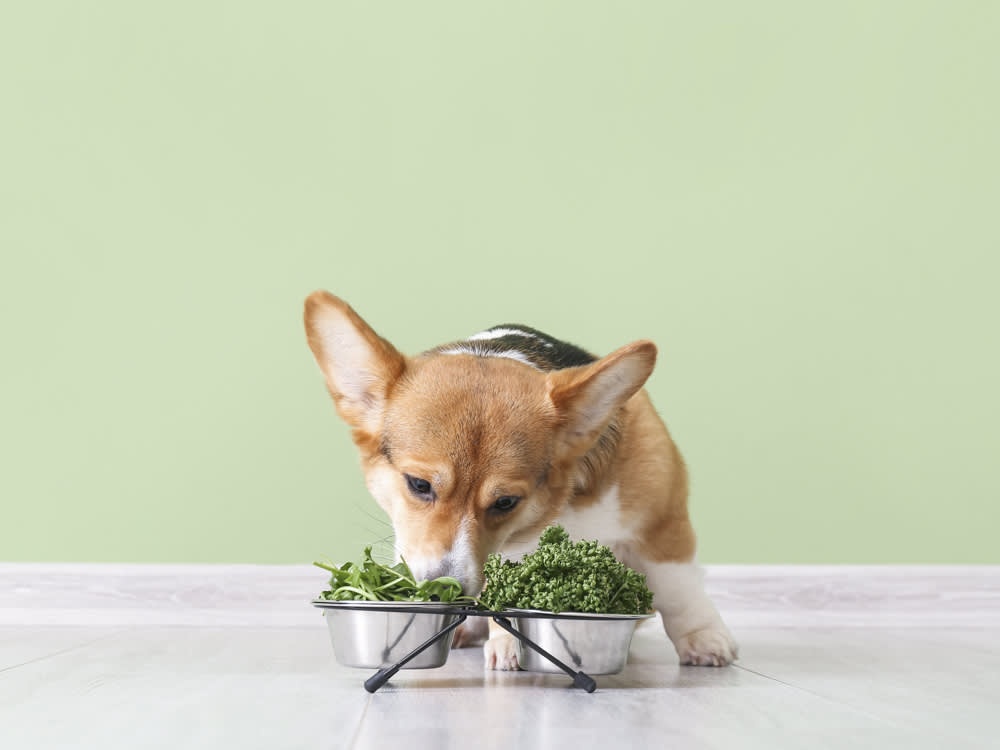Can Dogs Eat Kale?
Yes, this superfood is good for your dog in small amounts

share article
Kale has long been touted as a superfood perfect to toss into your smoothie and sneak in an extra nutritional boost (without the incredibly rough texture). Turns out this star on the food pyramid is also a nutritional boon to your dog’s health.
In general, leafy green vegetables pack a ton of vitamins, minerals, carotenoids and flavonoids. Many fall into the cruciferous family, which includes kale, spinach, chard, mustard greens, beet greens, collards, dandelion greens, broccoli, cauliflower, cabbage, bok choy and brussels sprouts. If you’re looking to add more leafy greens to your dog’s diet, kale is a good place to start – as long as you feed it to your pup in moderation. Here’s how.
The health benefits of kale for dogs
A rich source of vitamins A, B6, C and E, as well as folate and manganese, kale also provides thiamin, riboflavin, pantothenic acid, and several minerals such as iron, potassium, and phosphorus. Additionally, kale is a great source of two main antioxidants, lutein and zeaxanthin, which can potentially protect your pup from cancer.
Adding small amounts of kale to your dog’s diet can support vision and colon health and liver detoxification; it can also help stave off infections. And, if your dog needs to drop a few pounds, lightly cooked kale can be added to their meal as a topper, increasing their satisfaction without adding too many calories.
Types of kale
There are three main types of kale. The sweetest, Lacinato (also called dinosaur or Tuscan kale) is dark green with long flat leaves, and it’s the easiest to use. Then there’s curly kale, which – you guessed it – has very curly, green leaves that are somewhat bitter. And the mildest of the three types is a Russian variety with lobed leaves and magenta stems.
How to add kale to your dog’s diet
Kale is a great addition to your dog's diet, as long as you feed it to them in small amounts – too much can cause gastric issues, kidney or bladder stones, and/or thyroid disfunction. Here’s how to safely feed it to your pup.
Steam or blanch it
Boiling diminishes kale’s nutrient profile, so it’s best to lightly steam or blanch it. To blanch kale (and other vegetables), quickly submerge it first in boiling water and then in very cold ice water. Blanching is not only a good way to prepare leafy vegetables, it also cleans off any dirt that may be clinging to the leaves and helps retain more of the vegetable’s vitamins and flavour.
Sauté the stems
Most recipes intended for human consumption advise you to strip the leaves off their woody stems/ribs before cooking. But when using it for dogs, you can include the ribs by chopping or pulverising them and then lightly sautéing or roasting them. You can also freeze extra stems to add to a future meal for your dog. (Do not feed the stems to your dog if they are prone to kidney and bladder stones.)
Massage the leaves
First, finely slice or chop the leaves. Then, massage them by hand for a couple of minutes, which will make them tender enough to eat without cooking. Still, you may want to lightly sauté them before serving to your pup.
Puree the leaves and stems
You can also puree steamed or blanched kale – leaves and ribs included – in a food processor or Vitamix-type blender. Add a splash of the steaming or blanching water to make pureeing easier.
Add it to a smoothie
Whip up a dog-friendly superfood smoothie using kale, blueberries, banana, yogurt, chia seedsopens in a new tab and other fruits/vegetablesopens in a new tab. Add a few spoonfuls to your dog’s food as a meal topper or sneak it into a stuffed Kong and then freeze the Kongopens in a new tab. You could also freeze the smoothie in silicone forms or ice cube trays to make refreshing lickable summer treats.

Claudia Kawczynska
Claudia Kawczynska was co-founder and editor-in-chief of The Bark for 20 years. She also edited the best-selling anthology Dog Is My Co-Pilot.
